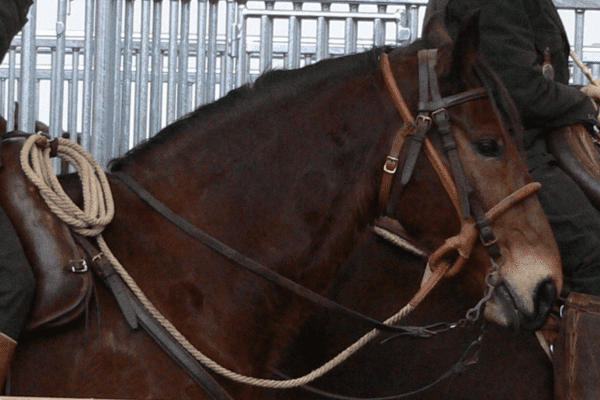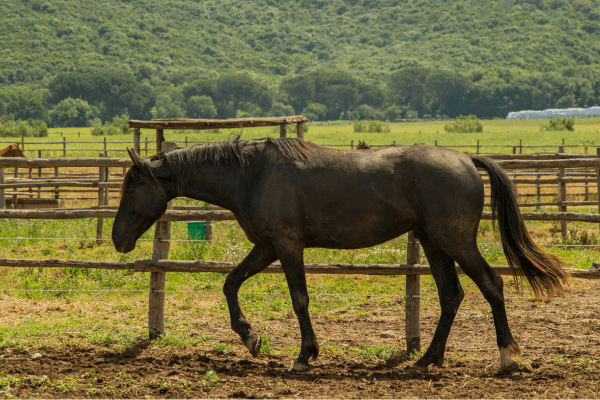The Maremmano breed, with its origins deeply rooted in the fertile lands of the Maremma region straddling Tuscany and northern Lazio, epitomizes the rich equine heritage of Italy. Esteemed for centuries as a robust working companion, this breed was integral to the Butteri, the traditional herders of the region, adeptly assisting in the management of livestock.
As times evolved, so did the role of the Maremmano, gradually shifting from a workhorse to a more sophisticated saddle horse. This transformation has been further enhanced through strategic crossbreeding with Thoroughbreds and other prominent breeds, leading to the emergence of the Maremmano migliorato, or “Improved Maremmano”.
History
The Maremmano horse has a rich and mysterious past that spans millennia of breeding. Thought to have originated in North Africa’s ancient stock, over centuries through selective breeding it has evolved through diverse bloodlines to its current form, which combines Spanish, Barb, Neapolitan and Arabian influences that all contribute towards creating unique characteristics found only within this breed.
In the 19th century, Maremmano’s development took an unexpected and dramatic turn when breeders introduced Thoroughbred and Norfolk Roadster bloodlines into its breeding program, marking a new era for Maremmano development and evolution.
Breeders’ introduction of these bloodlines resulted in the Maremmano becoming less rugged over time with refined physical characteristics more akin to Thoroughbreds than its traditional robust appearance – however this also meant less hardiness and stamina due to compromising its hardy heritage.
Maremmano horses continued their evolution into the 20th century with regular infusions of Thoroughbred genes, producing more refined horses with taller statures and enhanced athleticism.
At around this same time in Italy’s Pesaro province a crossbreeding experiment between Freiberger horses and Maremmmano lines resulted in Catria Horses as an adaptable legacy breed reflecting both adaptability and lasting influence of its lineage.
The history of Maremmano horses is one of genetic artistry and adaptability, reflecting breeders’ pursuit of elegance with endurance in this magnificent breed. Now living legend, they represent not just an equine breed but an important chapter of human creativity as they stand as living pieces of history – representing centuries of evolution alongside human ingenuity.

Characteristics:
The Maremmano breed stands as an embodiment of elegance and resilience for horses, boasting exceptional features that distinguish it in the industry. Standing an impressive 15 to 15.3 hands (60 to 63 inches or 160 cm), these horses exude dignity with their dignified yet robust stature.
Maremmmano horses typically exhibit colors such as bay, brown, dark chestnut and black; creating an impressive and authoritative presence for each horse in this breed. Gray and roan variants also add variety and variety within this unique breed.
One of the Maremmano’s most striking characteristics is its long, robust head. This feature is complimented by muscular neck and broad chest that lead up to well-defined withers; such a conformation adds both beauty and physical prowess in one.
The Maremmano horse breed’s physical appearance is distinguished by a full chest and gracefully sloping shoulders, contributing to powerful yet agile movement. Additionally, their back is relatively short, complementing with their naturally athletic physique by way of an angling croup and sloped shoulders – characteristics which help amplify athleticism in performance.
Maremmano legs are an integral component of their anatomy, being solid, sturdy and well-structured. Furthermore, this breed features flexible joints and durable hooves – essential features for easily traversing challenging terrains.
Beyond its physical features, Maremmanos are widely celebrated for their remarkable adaptability to harsh climate conditions and rugged landscapes. Thanks to their inherent sturdiness and versatility, this breed makes an excellent choice for various equine roles ranging from leisure riding to more intensive physical tasks. A proud representative of their lineage, their timeless grace and resilience truly define a remarkable breed!
Maremmano in Culture and Society
Cultural Icon: The Maremma horse is a symbol of Maremma culture and history, often featured at local festivals and parades.
Conservation Initiatives: Conservation efforts of Maremmano horses recognize their historical and cultural importance while upholding their traditions and characteristics.
Temperament and Behavior
Calm and Steady: Maremmanos are well known for their gentle temperament, making them suitable for riders of all levels.
Intelligent and Trainable: Smart dogs are known for being easy to train, responding well to positive reinforcement and consistent handling.
Versatile Performance: These horses may appear calm, yet their versatility shines through when engaging in activities such as trail riding, dressage and show jumping.


Modern Application and Popularity
Equestrian Sports: Their agility and strength make horses ideal for participating in different equestrian sports and competitive events.
Therapeutic Riding: Due to their gentle temperament, Shire horses have become popular choices in therapeutic riding programs for helping those living with both physical and mental challenges.
International Interest: Although predominantly found in Italy, interest in Maremmano horses is growing internationally with breeders and enthusiasts highlighting their distinctive features.

